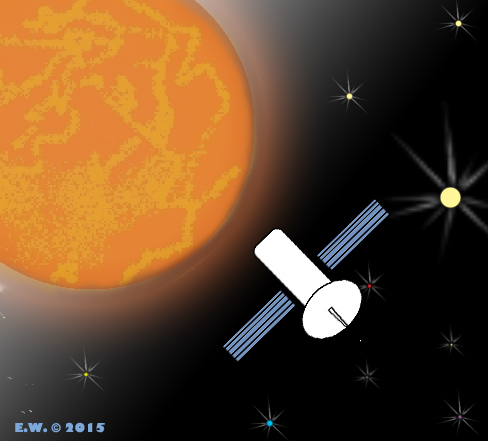
Scientists sometimes call far distant planets – far away worlds. One of those is the second planet in our solar system – called Venus. It was named after the goddess who according to Roman mythology had such functions as love, beauty, fertility, prosperity and other. It is the only unquestionable planet (in the meaning of classification) in our Solar system that got feminine name along with dwarf planets such as Ceres, Eris, Haumea and the asteroids.
Venus is a rocky planet with inhospitable environment caused by extreme geothermal activity. The atmosphere contains 96.5% of carbon dioxide, 3.5% – nitrogen, 0.1% oxygen, 0.05% – hydrogen oxide etc..
Planetary rovers cannot handle such tough environment and after the landing they usually get seriously damaged by an acid and the pressure.
High level of carbon dioxide has created the greenhouse effect that made an atmosphere so corrosive that asteroids usually dissolve before the contact with the surface. The temperature on the planet is approximately 470-500⁰C (878-932⁰F) and the pressure is about 76000 mmHg, while on the Earth we have average sea-level pressure 760 mmHg.
These conditions exclude even small chances for survival of bacteria and affects planetary rovers’ functionality. Studies from 60-70s of 20th century have shown that they cannot handle such tough environment and after the landing they usually get seriously damaged by an acid and the pressure. Therefore, space agencies study Venus during flyby missions.

This is a visual explanation how flyby mission looks like…
The surface of the planet is very diverse. The geothermal activity never ends because of close location to the Sun. During the billions of years, volcanic eruptions erected many landforms such as stratocones, tuff cones etc.. Even hill and mountains are result of undersurface activity. The highest mountain is volcano named Maat Mons. It’s height is 8.3 kilometres (5.17 mi), but Mount Everest (8.8 km (5.49 mi)) here on Earth is still higher. There are other geological formations which are still hidden under the layer of thin, but colored atmosphere and massive tornados that are visible from time to time to telescopes on Earth.
An atmosphere so corrosive that asteroids usually dissolve before the contact with the surface.
Another interesting feature called arachnoids. It is recognizable on the pictures made by NASA. These are deep, large cracks on planet’s surface that create something like cobweb mostly around the northern hemisphere of the Venus. There are 256 of them all over the planet. Astronomers have named only 55 structures of this kind.
The rotation of the planet is also different. It rotates very slowly. One day on Venus equals 224 days on Earth. Moreover, it spins in opposite direction than our planet. This means if we were there, we would see the sunrise from west to east, while on Earth it goes from east to west. Another interesting thing is that day lasts 243 days, despite the fact that one year is 224 days. But on Earth one year is 365 day, and 366 days in leap year. There is no need to make complicated calculations to conclude that duration of the day on Venus is 19 days. This is a paradox, but on planet the day is longer than a year.
In spite the fact that planet is an interesting object of studies, the astronomers have found that it extremely difficult because of reddish, nontransparent, corrosive atmosphere. But radar installed on the satellite can get more data about landforms and ongoing processes, so we can learn more about Earth’s sister planet. It also means that there is a huge field of studies for those, who want to bring new facts and undiscovered features of the planet to mankind.
Sources:
- http://www.britannica.com/topic/Venus-goddess
- http://nssdc.gsfc.nasa.gov/planetary/factsheet/venusfact.html
- http://solarsystem.nasa.gov/planets/venus
- http://www.universetoday.com/15054/how-long-is-a-year-on-earth/
- http://science.nasa.gov/science-news/science-at-nasa/2007/05jun_venusflyby/
- http://nssdc.gsfc.nasa.gov/planetary/chronology_venus.html
- http://www.universetoday.com/14319/how-long-is-a-year-on-venus/
- http://www.universetoday.com/47955/how-old-is-venus/
- http://photojournal.jpl.nasa.gov/catalog/pia00106
- http://apod.nasa.gov/apod/ap950928.html
- http://www.himalaya-info.org/Achttausender.htm#Mount Everest,8850m
- http://apod.nasa.gov/apod/ap980120.html